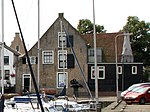Het Scheur

Het Scheur (Dutch pronunciation: [ət ˈsxøːr]; Dutch for "The Rip") is a branch of the Rhine-Meuse delta in South Holland, Netherlands, that flows west from the confluence of the Oude Maas and Nieuwe Maas branches past the towns of Rozenburg and Maassluis. It continues as the Nieuwe Waterweg (New Waterway) to the North Sea. Originally, Het Scheur was the northern branch of the river around Rozenburg island and curved south a few kilometres past Maassluis to join the Nieuwe Maas again in the Maasmond ("Mouth of Meuse") estuary near Den Briel. When the Nieuwe Waterweg was completed in 1872, Het Scheur was dammed off and connected to the east end of the Nieuwe Waterweg to form the new channelized main mouth of the Rhine-Meuse delta.
Excerpt from the Wikipedia article Het Scheur (License: CC BY-SA 3.0, Authors, Images).Het Scheur
Koning Willem Alexander Boulevard,
Geographical coordinates (GPS) Address Nearby Places Show on map
Geographical coordinates (GPS)
| Latitude | Longitude |
|---|---|
| N 51.915 ° | E 4.242 ° |
Address
Koning Willem Alexander Boulevard
Koning Willem Alexander Boulevard
3144 DT
South Holland, Netherlands
Open on Google Maps










